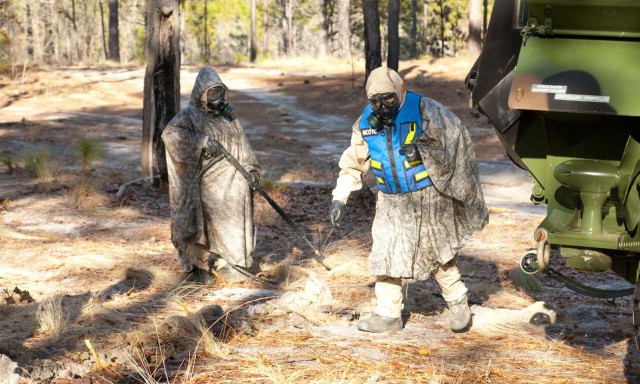
FORT BRAGG, N.C. - "I enjoy the protection aspect of the Army's decontamination program, as far as taking care of other Soldiers in the military," said Pvt. 2 Richard Coleman, a recent high school graduate who joined the military to support his wife and child.
Coleman and other members of the 83rd Chemical, Biological, Radiological and Nuclear Battalion were evaluated during a five-day training, Feb. 11 to 15, which took place in and around Forward Operating Base Patriot. At the training facility, located in a semi-remote area of Fort Bragg, platoons and battles were tracked from the site's tactical operations center - a large tent set alongside a dusty road.
Commanders evaluated the platoons on a number of factors, including knowledge of the mission, troop leading procedures and chemical decontamination criteria. About 477 Soldiers participated in the event, which pooled resources from the 83rd CBRN headquarters and 51st CBRN Co. (out of Fort Polk, La.) and the 21st and 101st CBRN companies stationed at Fort Bragg.
The 83rd CBRN is unique in that its Soldiers are spread over two states. "We bring a technical aspect that you don't have anywhere else. We're focused on being a force multiplier, not only now but in the future. We're focused on being able to respond to any kind of consequence management threat," said Capt. Kelly Miseles, assistant S3.
The battalion's current sensitive site assessment procedures went under the scope with a look at improving their chemical response capabilities.
Chemical response platoons already use stand-off capabilities, where they're able to test an area for contaminants from a safer distance. But internal site assessment is just as important in the field. Dismounting a vehicle, in full protective gear, and entering a 'hot' building is essential to increasing the battalion's effectiveness.
According to Miseles, "Hazardous Response Platoon's primary purpose is to do sensitive site assessment ... go into a location where there may be a development of biological weapons or hazardous materials, things of that nature. They have a greater defense capability and greater technological capabilities in evaluating whether the area needs to be exploited at a more detailed level.
"It's a very complex training exercise. We're integrating EOD support. We've got subject matter experts in the hazardous response field who are supervising that training - giving us feedback on how to improve what we're doing. We've really reached out and grabbed other organizations to help us in this training exercise," added Miseles.
The Fort Polk teams spent months preparing for the training mission. Each piece of equipment had to be analyzed for its relevancy to the training and Soldiers spent a day and a half loading equipment onto trucks to be sent to Fort Bragg. Five-ton vehicles, humvees, decontamination equipment (including water sprayers and brushes) and weapons systems made the final cut, and added to the exercise's sense of realism.
Capt. Peter Zappola, company commander, 51st CBRN Co., explained the day-to-day operations at FOB Patriot. "We're doing missions similar to what we always do, so the training events themselves are the same, but it's different terrain so they actually have to think about the routes and the locations. It forces you to do real-world land navigation and terrain association," he said.
In real-world situations, threats like those addressed by CBRN are few and far between. But when they do occur (or when an alert is put out), Soldiers need to respond like it's second nature. For Soldiers at FOB Patriot, this meant tactical training in chemical and nuclear reconnaissance and chemical and nuclear decontamination.
"I have people outside the wire right now conducting a recon of areas to do decontamination. So the situation is, some unit will be hit with a chemical attack, they'll ask for support from us, they'll bring a vehicle through (our decon stations) and we'll wash them off, scrub them down and let them return to readiness so they can continue their mission," said Zappola.
"We'll also get the missions where this road or this area has been hit with a chemical agent, or people in this area have been getting flu-like symptoms; which means a possible chemical agent attack, so we send our recon unit forward, in a mounted vehicle, to go in and sample the ground for chemical or nuclear decontamination," he continued.
"Then we can tell the commander, 'This road is free, this area is open and people can come through here' or 'No, it's dirty, wall it off'."

Social Sharing